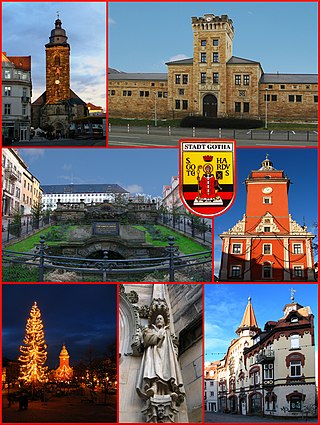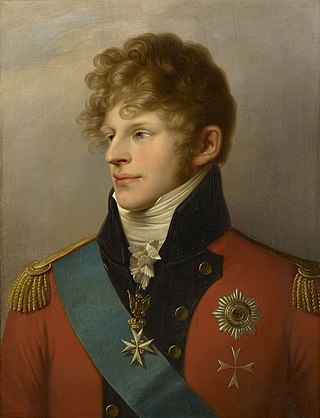
Saxe-Coburg and Gotha, or Saxe-Coburg-Gotha, was an Ernestine duchy in Thuringia ruled by a branch of the House of Wettin, consisting of territories in the present-day states of Thuringia and Bavaria in Germany. It lasted from 1826 to 1918. In November 1918, Charles Edward, Duke of Saxe-Coburg and Gotha, was forced to abdicate. In 1920, the northern part of the duchy was merged with six other Thuringian free states to form the Free State of Thuringia: Saxe-Weimar-Eisenach, Saxe-Altenburg and Saxe-Meiningen, Schwarzburg-Rudolstadt and Schwarzburg-Sondershausen, as well as the People's State of Reuss. The southern part of the duchy, as southernmost of the Thuringian states, was the only one which, after a referendum, became part of the Free State of Bavaria.

Saxe-Meiningen was one of the Saxon duchies held by the Ernestine line of the House of Wettin, located in the southwest of the present-day German state of Thuringia.

Gotha is the fifth-largest city in Thuringia, Germany, 20 kilometres west of Erfurt and 25 km east of Eisenach with a population of 44,000. The city is the capital of the district of Gotha and was also a residence of the Ernestine Wettins from 1640 until the end of monarchy in Germany in 1918. The House of Saxe-Coburg and Gotha originating here spawned many European rulers, including the royal houses of the United Kingdom, Belgium, Portugal and Bulgaria.

Saxe-Coburg was a duchy held by the Ernestine branch of the Wettin dynasty in today's Bavaria, Germany.

Saxe-Gotha was one of the Saxon duchies held by the Ernestine branch of the Wettin dynasty in the former Landgraviate of Thuringia. The ducal residence was erected at Gotha.

Alfred, Hereditary Prince of Saxe-Coburg and Gotha, was the son and heir apparent of Alfred, Duke of Saxe-Coburg and Gotha. He died aged 24 under circumstances still not entirely clear. He was a first cousin of Kaiser Wilhelm II of Germany, King George V of the United Kingdom and Tsar Nicholas II of Russia.

Frederick II, Duke of Saxe-Gotha-Altenburg, was a duke of Saxe-Gotha-Altenburg.

Frederick I, Duke of Saxe-Gotha-Altenburg, was a duke of Saxe-Gotha-Altenburg. He was born in Gotha, the fourth but eldest surviving son of Ernst I, Duke of Saxe-Coburg-Altenburg and Elisabeth Sophie of Saxe-Altenburg.

Augustus, Duke of Saxe-Gotha-Altenburg, was a Duke of Saxe-Gotha-Altenburg, and the author of one of the first modern novels to treat of homoerotic love. He was the maternal grandfather of Prince Albert, consort of Queen Victoria.

Marie of Württemberg was a daughter of Duke Alexander of Württemberg and Antoinette of Saxe-Coburg-Saalfeld. She was Duchess of Saxe-Coburg and Gotha from 1832 to 1844 as the second wife of Duke Ernest I. As such, she was the stepmother of Prince Albert, consort of Queen Victoria.

Schloss Rosenau, called in English The Rosenau or Rosenau Palace, is a former castle, converted into a ducal country house, near the town of Rödental, formerly in Saxe-Coburg, now lying in Bavaria, Germany.

The Saxe-Ernestine House Order was an order of merit instituted by Duke Friedrich of Saxe-Altenburg, Duke Ernst I of Saxe-Coburg-Gotha, and Duke Bernhard II of Saxe-Meiningen on 25 December 1833 as a joint award of the Saxon duchies.
Karl Ernst Adolf von Hoff was a German natural historian and geologist.

Schloss Weimar is a Schloss (palace) in Weimar, Thuringia, Germany. It is now called Stadtschloss to distinguish it from other palaces in and around Weimar. It was the residence of the dukes of Saxe-Weimar and Eisenach, and has also been called Residenzschloss. Names in English include Palace at Weimar, Grand Ducal Palace, City Palace and City Castle. The building is located at the north end of the town's park along the Ilm river, Park an der Ilm. It forms part of the World Heritage Site "Classical Weimar", along with other sites associated with Weimar's importance as a cultural hub during the late 18th and 19th centuries.

Johann Adolf of Saxe-Gotha-Altenburg, was a German prince of the House of Saxe-Gotha-Altenburg and a Saxon lieutenant general.

Friedenstein Palace is an early Baroque palace built in the mid-17th century by Ernest I, Duke of Saxe-Gotha at Gotha, Thuringia, Germany. In Germany, Friedenstein was one of the largest palaces of its time and one of the first Baroque palaces ever built. Friedenstein served as the main seat of the Dukes of Saxe-Gotha and later as one of the residences of the Dukes of Saxe-Coburg and Gotha, closely linked with the royal family of Great Britain through the marriage of Queen Victoria and Prince Albert. The final two ruling Dukes were both princes of the United Kingdom.

The Portrait of a Man in a Wide-Brimmed Hat is a work by the Dutch Golden-Age artist Frans Hals. It was painted in about 1625–1635 and hangs in the Herzogliches Museum, part of the Friedenstein Palace complex at Gotha, Germany. It was stolen in 1979, recovered in 2019, and restored in 2020–2021.

The Ducal Museum Gotha is a museum in the German city of Gotha, located in the Schlosspark to the south of the Schloss Friedenstein. Its collection was the art collection of the former Duchy of Saxe-Gotha, consisting of Egyptian and Greco-Roman antiquities, Renaissance paintings such as The Gotha Couple, Chinese and Japanese art, and sculptures from various eras.

The Museum of Nature Gotha is a museum in the German city of Gotha. Since 2004 it has been one of four museums run by the Schloss Friedenstein Foundation Gotha, named after the Schloss Friedenstein in the city. Particularly notable are the 1952-1954 hunting and animal-scene diorama backgrounds created by Friedrich Reimann, who also designed the murals in the entrance hall and stairwell.




















